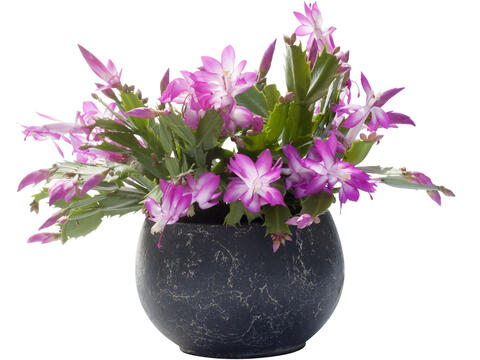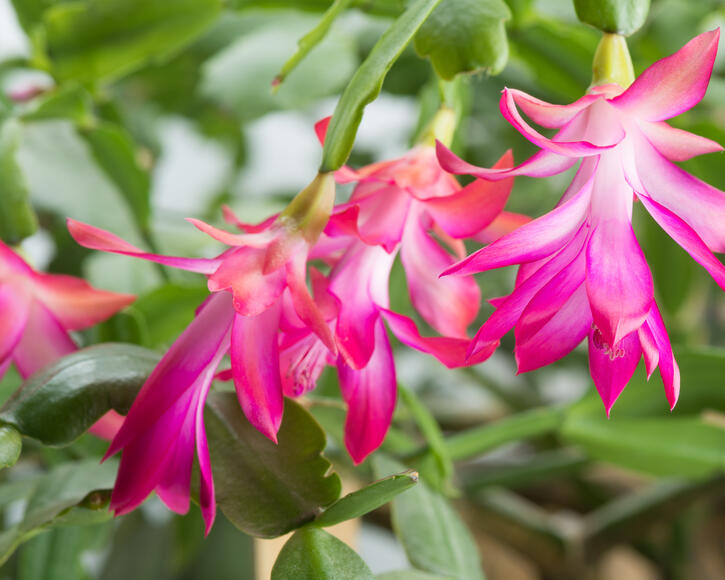Christmas cactus, Schlumbergera
In addition to the poinsettia, a popular house plant in winter is the Christmas cactus. The large, elegant flowers of the appear from November and bring color to the dreary winter. You can find tips about planting and caring for the Schlumbergera hybrids here.
Factsheet
- Growth type
-
- Succulent
- Growth height (from)
- from 20 cm to 40 cm
- Growth width (from)
- from 20 cm to 40 cm
- Growth characteristics
-
- bizarre
- overhanging
- flat growing
- tight
- Flower color
-
- yellow
- orange
- red
- pink
- white
- Flowering time (month)
-
- January
- November to December
- Flower shape
-
- terminal
- Leaf color
-
- green
- page format
-
- oblong
- multiple composed
- Sheet properties
-
- evergreen
- Fruit characteristics
-
- unimpressive
- Light
-
- sunny
- Soil type
-
- sandy to loamy
- Soil Moisture
-
- fresh to moderately humid
- ph value
-
- neutral
- Lime compatibility
-
- sensitive to lime
- Nutrient requirements
-
- nutrient-rich
- Decorative or utility value
-
- Flower Decoration
- Leaf ornaments
- Winter Hardness
-
- frost-sensitive
- Use
-
- Interior greening
- Planters
- Winter garden
- Garden style
-
- Pot garden
"Christmas cactus" is the common name for some species from the Schlumbergera genus, which belong to the cactus family (Cactaceae). They come from the Brazilian coastal forests, where they grow as epiphytes on large trees. The Christmas cacti cultivated for the apartment are purely hybrids, the wild varieties are not essentially indoor plants and are unfortunately all endangered in their natural locations. The Christmas cactus owes its botanical name to Frédéric Schlumberger, a French cactus breeder and collector.
Christmas cacti are cultivated as classic indoor plants because they are not hardy in our latitudes. As they bloom during the Christmas season, they are particularly popular Christmas decorations. Their drooping shoots make them ideal for tall vessels or hanging baskets, where the lush flowers can hang over the edge.
Despite being a member of the cactus species, the Christmas cactus does not have any real spines, but only fine bristles. The shoots are flat and fleshy and hang down, making the Christmas cactus particularly suitable for tall pots. With good care, the shrubby plant can grow up to 15.74 inches in size.

Characteristic of the Christmas cactus are its long, flat, medium green shoots, which consist of several leaf members, some of which are very differently shaped depending on the type and variety. The individual members are mostly elongated to ovoid and are either cut-in deep or shallow. Short bristles protrude from small areoles, found at the edge of the leaf limbs.
The attractive flowers of the Christmas cactus sit atop the shoot tips. The elongated flowers of the Schlumbergera are not longlasting — they only last an average of five to seven days. However, since they are formed in large quantities, the flowering period between November and January can last for several weeks. The flowers themselves are pushed together like scales and form a very beautiful inflorescence up to 3.93 inches long in different shades of red, pink or white. The petals are bent backwards, the stamens protrude slightly from the flower.
The Christmas cactus produces short berry-like fruits, which are, rather inconspicuous and has seeds no bigger than a fraction of an inch.
Christmas cactus hybrids do not like direct midday sun, but the location should still be bright enough. In summer, the plant can be outdoors in a partially shaded place. As a short-day plant, the Christmas cactus only forms buds when the days get shorter from 21 September and the average daily temperature drops to below 73.4 degrees Fahrenheit, but not below 50 degrees Fahrenheit. Placing it placed outside or in a cool bedroom is therefore ideal for stimulating bud formation in fall. Another important point if you want to make a cactus bloom: Less watering and no fertilization in the resting phase (end of August/beginning of September) until buds have formed. The best thing to do is to avoid artificial lighting in the evening so as not to artificially lengthen the light time of day — but it is not quite as sensitive in this regard as the poinsettia. Caution: After the buds appear, the plant must not be turned any more, because if the incidence of light changes, it often sheds all of the buds again before opening.
As a typical Christmas plant, the Christmas cactus is usually bought late in the year. It is best to put your Schlumbergera in a pot with high-quality, permeable potting soil to avoid waterlogging in the future.

One peculiarity of the Christmas cactus is its sensitivity to water with lime content, which can lead to the death of the plant. It is therefore best to water the plants with rainwater, boiled or tap that’s left out for a long time. The top layer of soil should always dry completely between waterings, but the root ball should be fully wet after watering. Wilted leaves are an indication that the soil is too moist. Regular spraying with low-lime water is also good for the woodland plant.
About every two to three weeks and while the flowers are forming, you should provide the Christmas cactus with some liquid fertilizer for cacti.
When the roots of the Christmas cactus fill their pot completely, you should repot the plant in a larger container. The best time for this is early summer.
Actually, the Christmas cactus hybrids do not need pruning. However, you can cut off individual members as required - for example if the plant has grown too big for you. The best time for this is end of the flowering period. Anyone who sticks the severed member in some soil can look forward to even more Christmas cacti.
The large, impressive flowers appear gradually from November to January. Multiple flowering phases one after the other are not uncommon with good care. The flowering phase should be followed by a period of about six weeks, during which the watering should be reduced and fertilization should be stopped. The vegetative growth phase begins in March, in which new shoots form. It lasts until the new flowers form in early fall.
The most common species are the crab cactus (Schlumbergera truncata) and the True Christmas cactus (Schlumbergera x buckleyi). The latter has rather erect shoots, which only lower with the years. The limbs of the shoots are rectangular with notched edges. The limb cactus is the most important parent of the hybrids available in our garden centers and nurseries. It has highly toothed leaf limbs and two tips at the end that look like small cones. It was voted Cactus of the Year 2014 by the German, Austrian and Swiss Cactus Societies.
To propagate Christmas cactus on your own, the leaf cuttings of the plant can be used. To do this, you twist off individual multi-part shoot members from the plant and stick them so deep in the potting soil, that they stand by themselves. At normal room temperature, they take root quickly and begin to grow after approximately four weeks.
The Christmas cactus is generally less susceptible to diseases and pests. Only mealybugs occur occasionally. If the Schlumbergera sheds its buds, this is not due to a disease, but due to incorrect care or planting it in a wrong location. Drafts, waterlogging, a very dry root ball or strong fluctuations in room temperature could be the cause.


